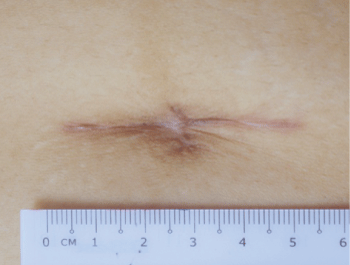Obstetrics and Gynaecology Cases - Reviews
Primary Umbilical Endometrioma: A Case Report
Lim Leek Mei* and Mickael Hoong Farn Weng
Sabah Women and Children's Hospital, Kota Kinabalu Sabah, Malaysia
*Corresponding author: Lim Leek Mei, Trainee in Obstetrics and Gynaecology Department, Sabah Women and Children's Hospital, Kota Kinabalu, Sabah, Malaysia, E-mail: leekiez@yahoo.com
Obstet Gynecol Cases Rev, OGCR-2-061, (Volume 2, Issue 5), Case Report; ISSN: 2377-9004
Received: June 22, 2015 | Accepted: September 28, 2015 | Published: September 30, 2015
Citation: Mei LL, Weng MHF (2015) Primary Umbilical Endometrioma: A Case Report. Obstet Gynecol Cases Rev 2:061. 10.23937/2377-9004/1410061
Copyright: © 2015 Mei LL, et al. This is an open-access article distributed under the terms of the Creative Commons Attribution License, which permits unrestricted use, distribution, and reproduction in any medium, provided the original author and source are credited.
Introduction
Endometriosis is a common gynaecological problem whereby there is presence of endometrial glands and stroma outside the uterus. This ectopic endometrium is predominantly found in the pelvis but may be present anywhere in the body [1-5]. Primary umbilical endometrioma also known as Villar's nodule is a very rare condition which incidence is reported to be 0.5-1% of all cases of extragenital endometriosis [1,2]. Due to its rarity, there are no clear guidelines on its treatment modalities. Main options in management are medical, surgical or conservative after ruling out malignancy [1-5].
Case Report
We report a case of primary umbilical endometrioma. She was a 41year old lady, para 1+1 with a background history of type2 diabetes mellitus, hypertension and a previous uneventful Caesarean section in 2005. She was subfertile since then.
She presented with scanty painless bleeding from the umbilicus for past 5 months which coincided with her menses. The bleed would start a few days before her menses and ceased by day two, in small amount and painless. Her cycles were regular with normal flow and no dysmenorrhea. She also noted blackish discoloration of the umbilicus. There was no other abnormal bleeding.
On examination, there was an umbilical nodule with dusky blue discoloration (Figure 1) with minimal bleeding, no other palpable abdominal mass. Vaginal examination was unremarkable. Abdominal-pelvic ultrasound and MRI were suggestive of umbilical endometrioma with suspicious implants in the sacrouterine ligament, uterus, vesicovaginal and bilateral ovaries.
She was counseled and opted for surgical intervention. She underwent a wide local excision of umbilical endometrioma with primary repair of the rectus in September 2014. A 2.2 × 2.5 cm supraumbilical pigmented lesion, adhered to omentum was resected with rectus breached. Histopathology examination showed endometrial glands and stroma, confirming the diagnosis (Figure 3 and Figure 4).

.
Figure 2: 5 months post excision, picture showing a well healed transverse scar over umbilicus.
View Figure 2
At 5 months post surgery, she was well with no disease recurrence nor menstrual abnormality. On examination, there was a well healed umbilical scar (Figure 2). She was a bit disappointed with the cosmetic appearance though.

.
Figure 3 and 4: Histology Examination:
Figure 3 (Left): Low power shows skin with underlying endometrial glands and stroma.
Figure 4 (Right): Hhigher power illustrate cystically dilated glands containing blood. The glands are lined by single layer cuboidal epithelium.
Interpretation: Umbilical lump consistent with endometrioma
View Figure 3 and 4
Discussion
Endometriosis involving abdominal wall is termed as cutaneous endometriosis which is commonly associated with surgical scar especially caesarean section, laparascopy and amniocentesis [1,2]. Ectopic endometrium occurring in abdominal wall in 0.03-1.08% of women with anamnesis of obstetrics or gynecology procedures [1]. Primary umbilical endometrioma is a very rare entity whereby there are no preceding scars [1-5]. Its estimated incidence is 0.5-1% of all cases of extragenital endometriosis [1,2]. Several pathogenesis has been postulated however the real mechanism is still yet to be determined. It is believed that the disease may be arising from metaplasia of the urachal remnants in case of isolated umbilical endometrioma [2]. It could be possible due to migration of endometrial cells to the umbilicus through the abdominal cavity, the lymphatic system or through the embryonic remnants in the umbilical fold such as the urachus and the umbilical vessels [2,5].
Based on our patient's presentation, despite the classical complaint of cyclical bleed from the umbilical nodule during menstrual cycle, we still have to be cautious of other differentials i.e. granuloma, lipoma, abscess, cyst, melanoma, primary or metastatic adenocarcinoma (sister joseph's nodule), primary cancer of umbilicus (basal cell & squamous cell carcinoma), Paget's disease [5].
Fine needle aspiration cytology (FNAC) is a fast and accurate way to confirm the diagnosis. MRI is non-specific but useful in determining the extent of disease [2]. Surgical treatment (wide local excision with margin of at least 1 cm) is recommended however patient should be warned of recurrence although recurrence is rare if the excision is thorough [5,6]. At times when there is suspicion of concurrent pelvic endometriosis, a laparascopy can be performed at the same setting [5,6]. Hormonal treatment may lead to incomplete regression but may be used to reduce its size for large umbilical endometrioma prior to excision which can improve the cosmetic outcomes [5,6].
References
-
Efremidou E, Kouklakis G, Mitrakas A, Liratzopoulos N, Polychronidis A Ch (2012) Primary umbilical endometrioma: a rare case of spontaneous abdominal wall endometriosis. Int J Gen med 5: 999-1002.
-
Fernandes H, Marla NJ, Pailoor K, Kini R (2011) Primary umbilical endometriosis-diagnosis by fine needle aspiration. J cytol 28: 214-216.
-
(2010) OGRM. Endometriosis.
-
RCOG Green Top Guidelines No.24 (2008) The investigations and management of endometriosis.
-
Carla IJ.M Theunissen, Frank F.A. IJpma (2015) Primary Umbilical Endometriosis: a cause of a painful umbilical nodule. J Surg Case Rep 3: rjv025.
-
Treatment of extragenital endometriosis (2013) Management of women with endometriosis; Guideline of the European Society of Human Reproduction and Embryology.






